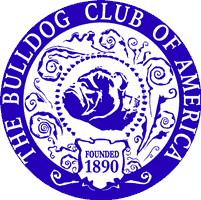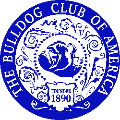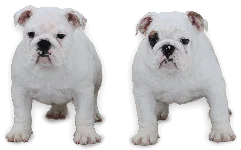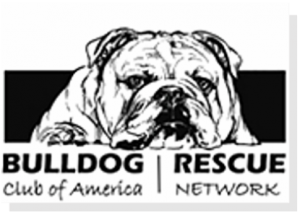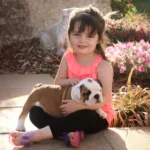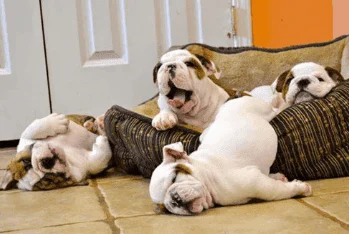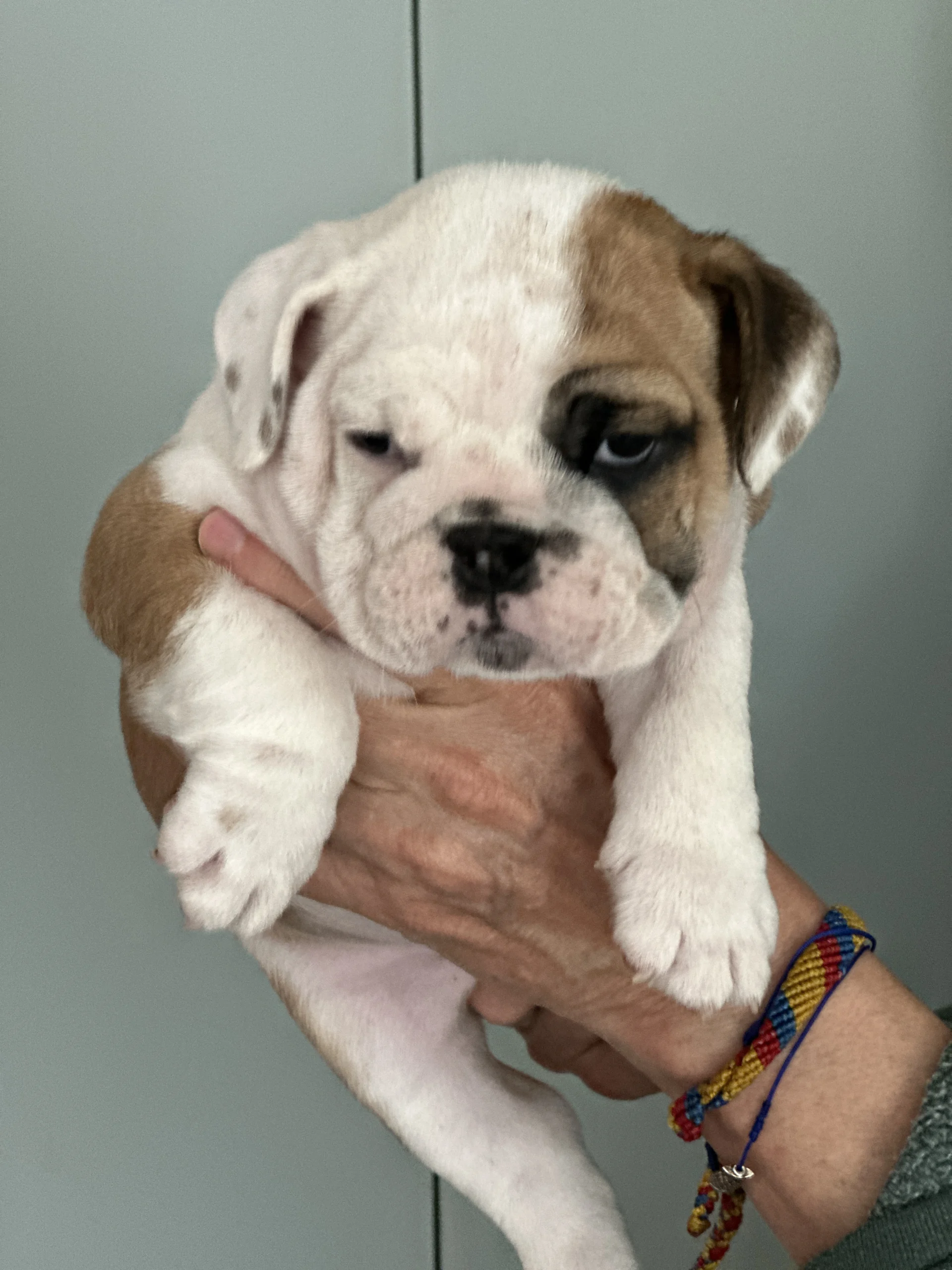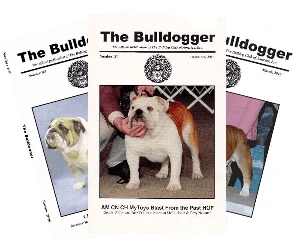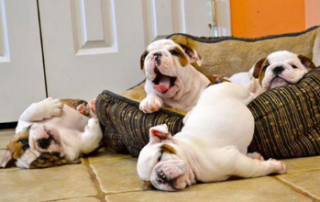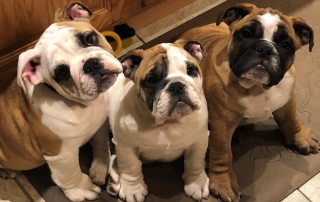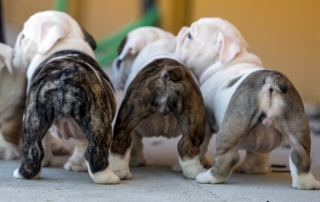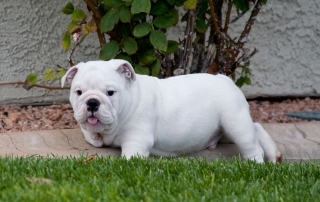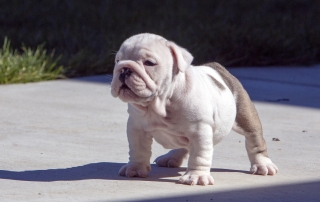When you plan on whelping Bulldogs a good Vet and your relationship with that Vet are of key importance to having a healthy mother and pups. The BCA has compiled a list of recommended Vets in your area. Your Vet should have checked the bitch before breeding and will see her again several times before whelping. An initial visit 28 or more days after the breeding will assess whether the bitch is pregnant. This can be done either by palpation (feel) or by ultrasound. In either case, you should have a good idea whether your bitch is pregnant, but you won’t know exactly how many pups your bitch is carrying. They also now sell home pregnancy tests for dogs which you can perform yourself. These are based on testing the bitch's urine. These are not the human pregnancy test strips. The dog tests look for a completely different hormone not present in humans.
Many breeders put their bitches on vitamin supplements during the period of pregnancy. Studies in humans have shown that folic acid deficiency can cause neural tube defects in children and, although most bitches are not malnourished, other deficiencies can cause birth defects. Human prenatal vitamin supplements provide a complete package of vitamins during this period. However, as with any medication, you should seek your Vet’s guidance before giving any supplements.
Be Prepared
About two weeks before the expected delivery date (which you should be able to predict accurately if you have used progesterone tests to target the date the eggs will be releases) your Vet will again see the bitch to evaluate the progress of the pregnancy. At about this time, many Vets recommend calcium supplements for the bitch to ensure sufficient milk development. From one week before the expected date of delivery onward, you should be in contact with your Vet daily. You will begin taking baseline temperatures on your bitch three times a day as you get close to the whelping date. You do it this often since temperatures vary throughout the day and you need to determine the bitch’s normal patterns. As you get closer to the delivery date, you will see more fluctuations and will begin to take her temperature more often to see if the pattern has changed. You do this because between 12 and 24 hours before the bitch will deliver, her temperature will drop. Having established her normal patterns will enable you to pick this up easily. This is the time to do the C-section.
You should wail until the temperature drops and not rely on a blind scheduled C-section since each day during the last week of the bitch’s pregnancy is equivalent to about a week in a human’s pregnancy. The neonate puppies will be healthier, larger and better able to survive if they are born at the time nature plans for the bitch to have them. You should get your Vet to agree to be available when whelping time comes. There usually is no rush; if you have been taking the temperature regularly, you will have about a day’s notice to do the C-section.
Time to Deliver
Some Vets will let you assist in the C-section and some will not. If you have a preference, you should discuss this with your Vet prior to the delivery. Extra hands to dry the puppies and get them breathing can be helpful, but if you are not comfortable with blood or pressure, this will not be the time to be involved.
With modern anesthesia, your bitch will walk out of the Vet's office about an hour after the C-Section is finished. She will be groggy, in some pain and is unable to climb stairs (and shouldn't until the incision heals). The anesthesia and pain makes many bitches pant for several days after the surgery. We ask our Vet to give her fluids and extra calcium before we take her home to make it easier for the bitch. This is a good precaution against dehydration and eclampsia. You should have an electrolyte enriched water for your bitch to drink for the first several days to ensure an adequate chemical balance. Pedialyte, a generic electrolyte or powders are all available and suitable for this task. Depending on your dog’s taste, Gatoraid may be something you can use.
You will need to have certain things on hand in preparation for bringing the puppies and the bitch home. You will need things for the puppies, for the bitch and for yourself. The items for the puppies and the bitch are discussed under the relevant sections below.
The items you will need for yourself are:
- A small, loud alarm clock to get you up at all those ungodly hours for feedings.
- A couch or place to sleep near the puppies or a monitor to transmit the sounds from the puppy room to wherever you are sleeping.
- A good coffee maker and plenty of coffee to keep the caffeine flowing.
- Dog books for advice on problems you know you read about, but can't remember because of sleep deprivation.
- A list of the important phone numbers, especially the Vet and friends you can ask questions of or get advice from in emergencies. You will need them and never be able to find them.
- Several copies in key places will prevent agitation looking for a number under stress.
- Lots of film and batteries for cameras so you can take those puppy pictures we all love to see.
- A phone in the puppy room, if possible. Don't ever leave your bitch with the puppies to answer the phone. Either use an answering machine and call back later or let whoever it is call you back. A few moments alone are enough for the bitch to inadvertently smother a puppy.
- Logs for the mother's temperature before whelping and for puppy records: weight, eyes and ears open, bowel movements, up on feet, etc. You will never remember half of it if you don't write it down.
We used to take the puppies home after whelping/C-section in a cardboard or styrofoam box in which we keep them for the first few weeks when they are not nursing. The box had a hot water bottle under a layer of pads to keep it warm during the trip home. Since pups can't maintain their temperature, this is critical for their survival.
When we get them home we set up a heating pad against one wall of the box and put a work lamp shining into the box. We adjust the setting on the heating pad and the direction of the lamp until we get the right temperature, about 90 degrees. We now use an incubator to raise young pups.
Other breeders only use hot water bottles, or incubators, or heating pads. As long as you feel comfortable and are sure neither to overheat nor cool the puppies, any alternative is acceptable. Remember, you want to have some variation in the temperature across the surface of the box so the puppies can seek the area which is comfortable to them, moving from hotter to cooler and back as needed.
After whelping the puppies should be kept in a temperature range of 85-90 degrees for the first five days in the box. After that you can gradually begin to reduce the temperature. The room temperature should be as close to 80 degrees as you and the bitch can stand - it's better for the puppies. While you need to be careful, don't overheat the room or the box. You don't want to dehydrate the puppies or the bitch.
We usually put a layer of lumpy material (e.g., rolled towels) across the bottom with a single towel or pad across the top, so the puppies have to exercise to move around. Just be careful that they can't get trapped underneath it.
To set up the box for travel and at home, you will need:
- Hot water bottle
- Heating pad - water proof
- Work lamp
- Towels, wash clothes and lambskin pads
- Two room thermometers (one for the room and a second for the whelping box).
Our first whelping box was 4 ft. by 4 ft., large enough for you, the bitch and the pups. You can purchase one, make your own or use a secure area where the bitch will feel safe.
If you just have to make your own, the walls should be at least 4 inches high, with the height depending on whether you have other dogs in the house. Most bitches will not tolerate other dogs around when she has pups. He maternal hormones and instincts are fully engaged and they may attack other dogs to keep them away from the pups.
You can build a whelping box out of a couple of sheets of plywood. The base is 48x46½ inches. This is raised two inches off the floor by 1x2 studs placed at the edges and in the middle. The space underneath lets us put a heating pad on one side to provide warmth, while creating a cooler side.
The sides are 48x7 inches, placed overlapping on outside next to the furring strips to create a square box. With the space underneath and the thickness of the plywood, the interior sides are about 4½ inches high. Four and one-half inch wide pieces are placed around the edge, resulting in a 3½ inch overhang. This provides a safe area for puppies where the bitch can't lie on them You can either miter the ends or butt them. In either case, a brace or angle iron should be used for extra support.
The pieces are glued and screwed together to increase strength. The entire box is coated with polyurethane to ease clean-up. A removable (to ease cleaning) rubber mat is laid across the bottom to provide footing and stability for the towels, etc. used to line the box. Frequent changes are needed to maintain cleanliness and you will be doing lots of washes.
With this design, you can sit on the edge of the whelping box without fear of collapse and there is room in the box for the bitch to nurse while you sit with her. Clean-up is relatively easy; requiring vacuuming loose food and damp-wiping spills.
To build the whelping box we described, you will need:
- 1 piece of 4x8 foot, ½ or ¾ inch plywood, cut as follows:
- 1 piece 48x46½ inches
- 4 pieces 48x7 inches
- 4 pieces 48x4½ inches (to be cut depending on whether you use butt or mitred ends)
- A total of 20 feet of 1x2 inch furring strips cut to appropriate lengths
- About 40 screws 1½ to 2 inches long to secure the floor to the furring strips and the sides to the top of the box.
- About 20 screws 1¼ to 1½ inches long to secure the sides to the furring strips.
- Carpenter's Glue
- A quart of polyurethane
- A 3-inch paint brush
- Turpentine or mineral spirits
- Several sheets of sandpaper
- Lots of towels, wash clothes, lambskin pads and old blankets, both for the whelping box and the puppy box.
Bitches differ in their attitude towards motherhood.
Some can't understand what these strange things are or where they came from. Remember, they were asleep when they arrived and even though you told her about puppies, she probably didn't really understand. Others want to spend all their time with the puppies and clean them naturally.
Some bitches will want to spend time in the whelping box and will use that as a bed. Others will find it more comfortable if you have their familiar crate or bed close by. Only her behavior will tell you which is best.
You also will want to be able to take her temperature if she seems feverish after surgery.
To set up a place for her, you will need:
- A crate or bed and bedding.
- A rectal thermometer, preferably digital.
A whelping box can be used for feeding puppies and for permitting mother-puppy bonding. We use the whelping box for feeding from day one and put the pups in it with the mother for periods of getting to know each other as soon as the bitch is ready. We will leave the puppies with the bitch once they are strong enough to move from under her if she accidentally sits on them.
Some bitches will take naturally to mothering, others won't. You will have to spend a lot of time working with those who do not take to mothering, making sure the puppies get fed and don't get sat on.
The natural mothers will let you know after a few days or a week that they are ready to take over. They may do this by growling at you when you try to handle the puppies. Let them take over. You will hold your breath the first time they pick up a puppy (they do use their mouths, not their hands). If they are good at mothering, they will come running when a puppy cries and will quickly learn to watch where their feet are so they don't step on anyone and to lie down so the puppies can nurse.
You have to remind them that although they may be in charge of mothering, they still have to listen to you. She will need to be told in a friendly, humorous voice that she is ridiculous if she thinks she can boss you around. At the same time, reduce your presence in the puppy room - watch from outside the door and keep intrusions to the minimum needed to make sure all the puppies are eating and are safe. Once she has learned that you accept her as boss of the puppies, she will ease up.
The bitch will probably not want to eat for the first few days after whelping. It is crucial that she gets food into her in order to prevent eclampsia (milk fever) and hypoglycemia and to have enough milk to feed the puppies.
You should mix up a batch of whatever she likes best combined with nutritious food in order to provide her with a high protein and high carbohydrate diet. We mix beef or chicken livers with high quality dry dog food (e.g., Pro-Plan Growth).
We soak about eight cups of the Pro-Plan in evaporated milk to soften it. Liquefy the liver (or whatever you use) and mix it about 25% liver/75% Pro-Plan. Add one bottle of light Kayro syrup (to prevent hypoglycemia) and about five scoops of dry Esbilac, if you wish. Add about 4 cups of rice (2cups dry added to 4 cups of water) to reduce the chance of loose stools. Add in two small packages of spinach (to increase iron). Chop it in a food processor or blender until smooth and put in the refrigerator until needed.
She will probably need to be coaxed initially and may prefer a loose mixture. If so, dilute with evaporated milk until you get a consistency she likes. Eventually she will tolerate more solid food and you can feed the mixture like meatballs.
To prepare a high protein and high carbohydrate diet, you will need:
- Esbilac (at least a 2-pound container of dry)
- Karo syrup (light colored)
- Liver (or whatever else she likes)
- 4 cups of dry rice (plus 8 cups of water)
- Evaporated milk
- A high quality growth dog food (we use Pro-Plan Growth)
- Spinach
In order to maintain her fluid balance in the first few days after whelping, it is good to have an electrolyte supplement for the bitch if it's hard to feed her. She should be given calcium supplements in order to prevent eclampsia. Your bitch may experience tremors post surgery as a reaction to the anesthetic. Talk to your vet. Ours will give calcium shots and glucose to prevent more serious problems if tremors appear.
Keep plenty of water available at all times and have ice ready. Since she will probably be panting from both pain and excitement.
To take care of other nutritional requirements, you will need:
- An electrolyte solution, like pedialyte, pediatric stat (Stat VME).
- Calcium/Potassium supplements
- Water bowls and ice
You are going to need to get along on little to no sleep for a couple of days. When the puppies come home, they will have to nurse every two to three hours around the clock. You will have to be there to supervise and make sure everything goes O.K.
All bitches need to learn how to nurse the puppies. It helps if they know how to lie down on command. Otherwise, you will have to get her to lie down. This can usually be done by having her sit and pulling the front legs forward.
Your puppies should be able to nurse on the bitch when you get home. The first feeding will be about 1-2 hours after you return home. You can then put the puppies on her nipples. Most bitches do well if there are two people there, one to deal with the puppies and another to sit by the bitch's head, reassuring her.
The puppies don't know about nursing from a nipple, so you need to set it up properly. Place their tongues under the nipple so it naturally curves around it. They should begin to suck. If they lose the nipple, reattach them; in the beginning, they won't be able to do it for themselves.
Over time, you will see which puppies are the strong nursers and which are weaker. Some will do better on certain nipples than on others. The nipples towards the rear of the bitch tend to produce more milk than those towards the front. An aggressive nurser can aspirate the liquid. You will need to get the liquid out of the lungs to prevent pneumonia.
You can either use an aspirator bulb. To use the aspirator, place the deflated aspirator bulb in the nostril and draw the liquid into it. This usually works quite effectively.
Never leave you your puppies alone with the bitch. New mothers are unpredictable. Some may attack the puppies or attack you. Keep all other animals away, since they tend to be protective of the puppies and even the best of friends may be attacked by the bitch at this time.
It is important for the puppies' health that they be kept clean and important for your psychological health that the puppy room be kept clean. You will be using massive amounts of paper towels and baby wipes, cleaning up bleeding by the mother and accidents she has before she adjusts to the new setting.
When the pups are born, they are unable to eliminate on their own. You have to gently stroke their genitals and anus after each feeding to stimulate urination and defecation. They won’t eliminate after every feeding, but you must try to stimulate them to do so to see if they will . A good mother will gradually begin to do this herself, removing you from the process. Baby wipes, etc. are best for this cleaning. Some pups started eliminating on their own by the second day. This creates problems cleaning up their box and crusting on the pups. The paper towels are needed here as is the Vaseline to reduce irritation to the pups.
Nursing will stimulate contractions in the bitch, causing her to release blood clots from the surgery. This is natural. She will also get very messy from your feeding her. There will be lots of clean-up here.
If you spot any fleas on your bitch, this is a good time to comb them out. Depending on the season, you will not have used any flea or tick preparations in two months, so their presence is a possibility. She will appreciate the attention and getting rid of the fleas will prevent potential problems with the puppies.
- Large size garbage bags in the puppy room.
- Many rolls of paper towels.
- Cotton balls, tissues or baby wipes (without alcohol) to clean the pups.
- Hydrogen peroxide and Vaseline to prevent irritation.
- Flea comb
If your bitch is temporarily unable to nurse after whelping or because of eclampsia, if there is insufficient milk to feed the puppies initially or if there are too many pups to nurse at one time, you will have to hand feed them with a milk substitute, like Esbilac. If you have a lot of puppies, you may also have to supplement their regular nursing.
Some people like using stomach tubes. If you want to, get your Vet to show you how to do it. The procedure places a small tube into the stomach (avoiding getting it into the lungs on the way down) and permits you to introduce exact amounts of milk substitute into the puppy's stomach. Once you learn how to do it, this is a fast and clean way to feed a litter of puppies.
Others use syringes or bottles with artificial teats attached. Human orthodontic nipples have worked effectively for us, using the smallest size. This lets you meter the exact amount, while giving the puppy experience at nursing. This will hold it in good shape for when it does nurse.
To set up for nursing, you will need:
- An baby aspirator
- Esbilac (at least a case of liquid)
- Nursing bottles with orthodontic or a five-cc syringe with Catac small teats
- Lactobacillus acidophilus bacteria for use in case the pups have diarrhea or their stool is loose to improve intestinal bacteria and aid digestion.
You will want to check the effectiveness of the nursing by weighing the puppies. In the beginning, the puppies should be weighed at least daily, always at the same time, either before or after feeding. It is not unusual for puppies to lose some weight the first day as they learn to nurse. Different lines also gain weight at different weights after whelping. Check with the breeder of your bitch to determine what you should expect. Our first litter gained an average of about 7/10 of a pound in the first week, while our second one gained about 4/10 of a pound. Talking to the breeder reassured us that this was normal in her lines and not a sign of potential problems.
You will be spending a lot of time with the puppies and will get to know them very well. Be sure you can easily identify each puppy (e.g., male brindle with white neck) to keep your records of growth, bowel movements, etc. straight.
To monitor growth, you will need:
- a scale which will handle between 1 and 25 pounds and which will let you read accurately in at least ½ pound increments.
As the puppies grow, they will need more secure space than the whelping box. They will also have to be weaned from the mother.
Puppy pens have adjustable grid floors, which are initially placed near the top. As the puppies grow, the floor can be lowered to provide them additional height. A wire grill covers the top to prevent the puppies from climbing out. These are available in most pet supply houses. The best sizes are 3x3 feet or 4x4 feet, depending on the amount of space you have and the number of puppies you have to hold.
The timing for moving the puppies to the pen will depend on the puppies' rate of maturation. They can stay in the pen until you give them their own crates.
At the same time, the puppies should shave some toys especially for them. Old socks rolled into balls or soft puppy Nylons can provide amusement, entertainment, and stimulation for the puppies. Just remember not to let them play with socks for too long or they will always think your socks are toys. This can lead to problems getting enough socks to match for you to go to work.
There are special puppy bowls. They have a bottom which slopes outward from the center to push mostly liquid food towards the edges. The age of weaning varies. We have had litters begin weaning at three weeks; others were later. Puppies' teeth are very sharp and the bitch will start to hurt from nursing as their teeth come in.
You can start teaching the puppies to take liquid Esbilac from the bowl as soon as they are coordinated enough. If you chop the moist growth dog food in a food processor and make a loose mixture with liquid Esbilac (similar to what you did for the bitch), the puppies can learn gradually to take more solids from a bowl.
As they get still older, the mixture is made more solid until they are eating dry growth dog food soaked in Esbilac and then plain growth dog food. They are guaranteed to walk in the food bowl and it will be messy, but they will eat on their own.
In order to wean the puppies and make enough space for them to play and grow, you will need:
- A puppy bowl.
- A puppy pen
- Soft puppy toys
